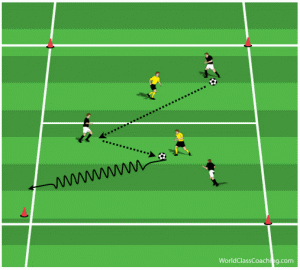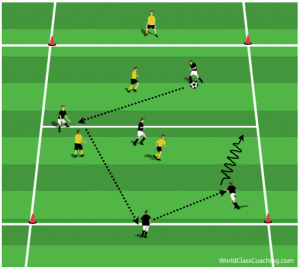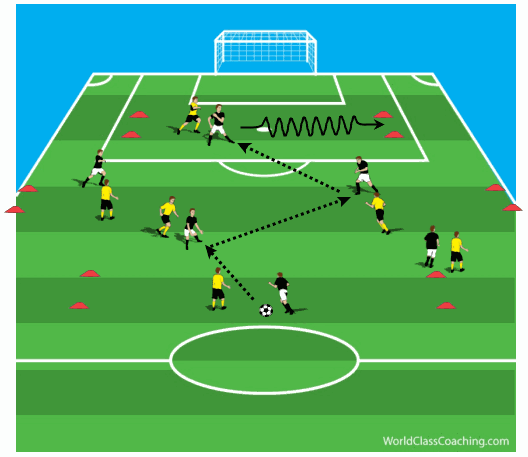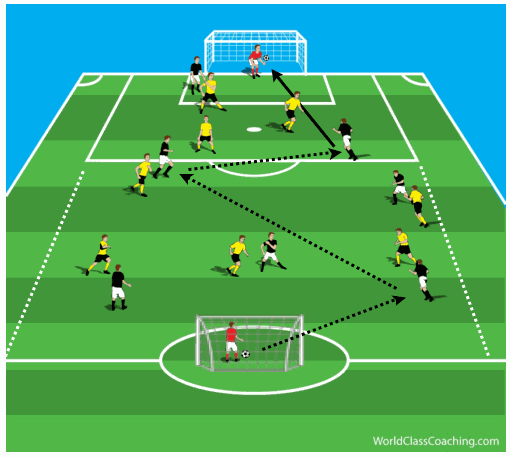By Chris Kouns
USSF A License (USSF Coaching Education Instructor) – NSCAA Premier Diploma (NSCAA Coaching Education Associate Staff Coach) – Head Coach Capital University Women’s Soccer (OH)
These activities will put players into situations where their space is limited forcing them to recognize tactical options more quickly and develop better problem solving.
Activity 1
Set up involves a grid that will be (roughly) 12x15 depending on the technical ability of your players. There will be three (3) players on one team vs two (2) players on the other team. Within an allotted time period the three will try to maintain possession of the ball for as long as possible. If the defending team wins the ball they will look to dribble outside of the grid in possession. However, if the defending team wins the ball but the attackers can win the ball back prior to their exiting the grid then there is no time penalty.
OPTION A
For two (2) minute time period one the team of (3) will attempt to maintain possession for as long as possible without allowing the defense to win the ball and exit the grid. If the defense is able to exit the grid with the ball then subtract 10 seconds from the longest time in possession for the (3) players. The longest time period in possession will be recorded and that will be the score for that team of (3). As you rotate the teams of (3) the longest time period (within the two minute game) that they kept possession will win.
OPTION B
For a one (1) minute time period the (3) players must try to combine around the two defenders as many times as possible. Common combinations will be give and go or wall pass combinations but you could see take over or overlap options as well. The same rules apply for the (2) defenders, except, this time a successful exit from the box negates one combination from the attacking team total
Coaching Points
- If working for time in possession the player on the ball must keep their hips open to the
other two players so their options will be readily available. - If working to achieve combinations then the player with the ball at their feet must engage
a defender and initiate the movement of the other players by taking that player on. - Players off the ball must quickly read the tactical cues of space and body position and
then move into positions where they can receive the ball from the player on the ball.
movement within the small space must always be made in an open position to the
ball and should not include turning back to the ball. - Moving the first touch of the ball to space (Identified prior to receiving the ball) is a must
To set the table for proper decisions.
Activity 2
Set-Up involves a grid roughly 15 x 20 yards again
depending on the technical ability of your players. one Team will have 4 + 1 while the other will have 3 + 1.
Each team will attempt to possess the ball and when possible they will look to involve the player on the end line for their team as a way of helping maintain a Positive shape in a limited area. Game does not end on a turnover, rather, it is an opportunity for transition.
OBJECTIVE
For a two (2) minute time period each team will attempt to win possession of, and keep possession of, the ball. The team that is able to keep possession the longest will win the round. However, the team that is down a player will be given a +5 second advantage.
OPTIONAL PROGRESSIONS
- When ball played to end line player they must dribble into the field of play and the closest player on their team must replace them
- Teams can be even in numbers 3+1 v 3+1 to work on a different aspect. Uneven numbers force teams
To already be chasing the game (+5 sec. advantage) and trying to maintain the lead - Players on the end line may not play (or must play) a return pass to the player who gave them the ball. This will force them to recognize third man combinations as well as two player combinations
- After winning the ball the defending team must try to get across the end line where the other team has their (+1) player. If they are able to do so then they will maintain possession, however, if not able to do so the attacking team keeps possession.
Coaching Points
- The team that is numbers up should work to make the small space as “Big” as possible focusing on their body positions being open to as many options as possible.
- The team that is numbers down should look for a “security pass” as soon as they can win the ball which then must be able to find a player who has opened the space up (short then long). This ensures they will keep the ball and not be stuck in transition. Then it also allows them to use their opponents desire to win the ball back against them by having a player open the space up behind them.
- End line players should be in a constant state of movement. As they move their should keep their head on a swivel so they are aware of ALL the options around them for a one touch pass
- End line players must provide a clear target (with no defender between them and the ball) so that the player on the ball can eliminate lines of players while maintaining possession.
- Both teams must utilize an active first touch so that they can escape the tight space and move the ball into an area where they are better able to unbalance the defenders current defensive position.
Activity 3
Set up is a 6 v 6 contest played within one half of the field. Each team will have three goals to attack (suggested size per goal is roughly two yards depending on the level of your players. If you plan to allow the players to dribble through the gates to score then you can make them a bit bigger.
OBJECTIVES
Players will work together to get through any of the three goals via various different methods which will put them in game like situations in “tight” areas.
- Players must play a ball through the goal to another player running onto the ball in order for it to count as a point. The player may not be behind the goal prior to the ball entering the goal.
- Players must dribble the ball through the gate in order for it to count as a point.
- Players must combine to get through a gate in order for it to count as a point. Common combinations will be Wall Pass, Overlap and take over
Coaching Points
- Since the space behind the gate goals will be tight the timing of the run will be vital in order to get a point with the pass. Focus on making diagonal runs onto a straight pass or straight runs onto a diagonal pass.
- Work to avoid straight passes and straight runs as they are too easy to defend in such a tight space and will be the same in the real game
- When dribbling in such a tight space it is important to allow the first touch to eliminate as many defenders as possible. A big, attacking dribble will be most effective
- When working to combine through the gate it is vital that players open up the space to attack with movement and not be static around the cone goals. Movement away from the goal by a player not yet involved in the play can force a defender to vacate the space necessary for attacking.
- When looking to exploit the small space with combination play look for areas where your team will be numbers up over the defenders. With this numeric advantage you can find more options through the smaller opening.
Activity 4
Set up is a 7 v 8 activity played in two zones. In the zone within the box there will be two (2) attackers playing against three (3) defenders. In the space between the top of the box and the goal at midfield there will be 5 v 5. The players in each zone should not cross into the other zones in the flow of play.
OPTION
Players in the larger space may enter the smaller space within the box if the ball is played in to their attackers. This could be the player who gave the entry pass or a third man running player who comes in on the back side of the play.
OBJECTIVES
The team attacking with two (2) players in the box must work to find balls that the two can either A) shoot first time to negate the numeric & space disadvantage or B) the (2) must work together to quickly combine and create their scoring opportunity.
Coaching Points
- For the team numbers down in the box their movements must always offer the option to finish on the first touch.
- The players in the box who receive the ball must go at pace to attack a defender and not allow the close proximity of support to shut down their attack
- If a player is allowed to progress into the box with the attackers then that player must make their run into an area where they can unbalance the defense or where they can create an immediate numbers up advantage to be exploited.
By Chris Kouns: USSF A License (USSF Coaching Education Instructor) – NSCAA Premier Diploma (NSCAA Coaching Education Associate Staff Coach) – Head Coach Georgia Gwinnet College Women’s Soccer (GA)






